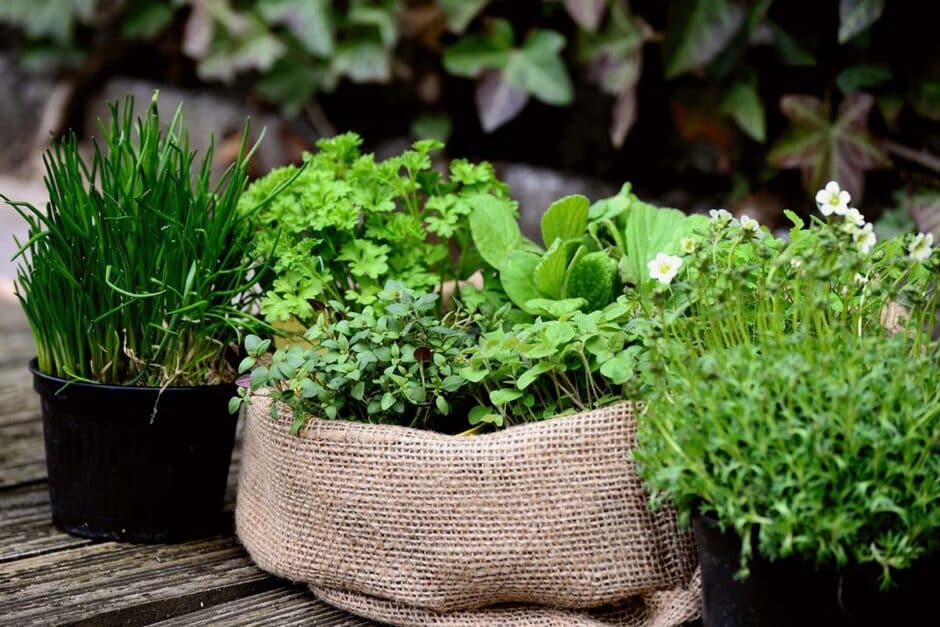
Growing a herb garden in the UK is a rewarding way to enhance your cooking, connect with nature, and add greenery to your space—whether you have a sprawling garden or a compact windowsill. This guide covers everything you need to know to cultivate a flourishing herb garden, tailored to the UK climate.
Key Takeaways From this Article About Creating a herb Garden
- Easy & Rewarding: A UK herb garden is simple to start, space-efficient, and enhances your cooking.
- Best Herbs: Hardy perennials like rosemary, thyme, and chives thrive in the UK climate.
- Ideal Growing Conditions: Most herbs need 6–8 hours of sunlight and well-drained soil.
- Small-Space Solutions: Grow herbs on windowsills, in containers, or raised beds.
- Year-Round Harvesting: Preserve herbs by drying, freezing, or making infused oils.
- Common Challenges: Protect against frost, pests, and overwatering with simple solutions.
- Indoor Options: Grow herbs inside using LED lights or hydroponic systems for winter greens.
Why Grow a Herb Garden in the UK?
Herb gardens are beginner-friendly, cost-effective, and perfect for the UK’s temperate climate. Fresh herbs like rosemary, thyme, and mint thrive in British weather, requiring minimal space and care. Benefits include:
- Year-round freshness (many herbs are perennial).
- Reduced food waste (harvest only what you need).
- Sustainable living (avoid plastic-packaged supermarket herbs).
- Pollinator-friendly (flowers like chives attract bees).
Step 1: Choose the Right Location
Most herbs need 6–8 hours of sunlight daily. In the UK, south-facing spots are ideal, but east/west-facing areas also work. For shady gardens, try hardy herbs like parsley or mint.
Options for Small Spaces:
- Windowsills: Perfect for basil, coriander, or chives.
- Containers: Use pots with drainage holes (clay or plastic).
- Raised beds: Great for gardens with heavy clay soil.
Step 2: Select THE RIGHT Herbs FOR YOUR GARDEN
Focus on herbs that suit the UK’s cool, damp climate:
| Herb | Type | Care Tips |
|---|---|---|
| Rosemary | Perennial | Drought-tolerant; thrives in full sun. |
| Thyme | Perennial | Well-drained soil; avoid overwatering. |
| Parsley | Biennial | Partial shade; keep soil moist. |
| Mint | Perennial | Grow in pots to control spreading. |
| Chives | Perennial | Tolerates light shade; cut regularly. |
Pro Tip: For beginners, start with hardy perennials like sage or oregano.
Step 3: Prepare Your Soil
UK gardens often have heavy clay soil. Herbs prefer well-drained, slightly alkaline soil (pH 6.5–7.5).
- Enhance drainage: Mix garden soil with compost or grit.
- Containers: Use peat-free multi-purpose compost.
- Raised beds: Layer soil with organic matter for better aeration.
Step 4: Planting Your Herbs
When to Plant:
- Spring (March-May): Safest for frost-sensitive herbs like basil.
- Autumn: Plant hardy herbs like thyme to establish roots.
Planting Guide:
- Space plants 30cm apart to prevent overcrowding.
- Bury roots at the same depth as their nursery pot.
- Water thoroughly after planting.
Indoor Herbs: Use pots with saucers to catch excess water. Rotate weekly for even light exposure.
Step 5: Maintenance Tips for YOUR HErb Garden
- Watering:
- Water in the morning to reduce evaporation.
- Avoid waterlogging—herbs like rosemary prefer drier soil.
- Pruning:
- Trim regularly to encourage bushy growth.
- Remove flowers from basil to prolong leaf production.
- Winter Care:
- Move pots indoors or insulate with horticultural fleece.
- Reduce watering for dormant herbs.
Step 6: Harvesting & Preserving
- Harvest in the morning when oils are most concentrated.
- Preservation Methods:
- Air-dry hardy herbs (thyme, oregano).
- Freeze soft herbs (basil, coriander) in olive oil.
- Make herb-infused vinegar or butter.
Common UK Herb Garden Challenges (and Solutions)
- Slugs/Snails: Use copper tape or organic pellets.
- Frost Damage: Cover plants with cloches in winter.
- Yellow Leaves: Often a sign of overwatering—adjust drainage.
Indoor Herb Gardens for Year-Round Growth
Even in gloomy UK winters, you can grow herbs indoors:
- Light: Use LED grow lights for 12–14 hours daily.
- Herbs to Try: Basil, parsley, and microgreens like cress.
- Hydroponics: Compact systems like Click & Grow work well for flats.
Final Thoughts
Creating a herb garden in the UK is simple, sustainable, and satisfying. Start small, experiment with resilient varieties, and enjoy fresh flavours at your fingertips. Whether you’re in a Cornwall cottage or a London flat, herbs offer a touch of greenery and gourmet charm, packed with flavour.
If you would like to know more about herb gardening, then please read this article by the RHS website, or my own article on the topic of ‘Grow Herbs for Health and Wellbeing – Natural Medicine‘.



